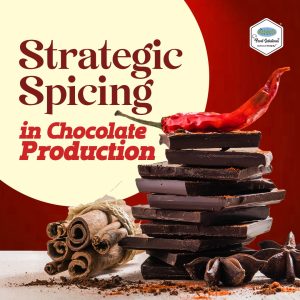
The chocolate industry is experiencing a profound transformation. Sophisticated consumers increasingly demand innovative experiences, propelling flavoured chocolate products to achieve remarkable 23% growth over three years, with spice-infused varieties leading this expansion.
The global chocolate market, valued at £95-134 billion in 2023 and projected to reach £125-176 billion by 2030, is witnessing its fastest growth in premium segments. Spiced chocolate products command premium pricing of 15-30% above standard varieties whilst achieving superior margins and building stronger brand loyalty amongst increasingly discerning consumers.
For food and beverage professionals, this evolution presents both exceptional opportunities and complex technical challenges requiring mastery of volatile compound interactions and precision manufacturing protocols.
The Sophisticated Modern Consumer
Today’s chocolate buyers represent a dramatically evolved consumer base. Research reveals that 77% actively seek chocolate with reduced sugar content, 69% desire healthy ingredients, and 52% specifically purchase dark chocolate for health benefits. This creates unprecedented opportunities for spice-integrated products delivering both indulgence and functional benefits.
The wellness movement has fundamentally influenced purchasing decisions, with consumers drawn to spices offering proven health benefits. Adaptogens such as ashwagandha, turmeric, and cardamom are gaining significant traction, with 68% of consumers believing botanicals enhance chocolate’s healthiness.
Critically, Millennials and Generation Z drive 67% of premium chocolate purchases, demonstrating particular preference for products with compelling origin stories and sustainable sourcing practices.
The Science of Successful Integration
Creating exceptional spiced chocolate requires sophisticated understanding of molecular interactions. Cocoa contains over 600 volatile compounds, and successful spice integration depends upon complementing rather than competing with these natural elements.
Temperature management becomes critically important as volatile compounds behave differently at various temperatures. The optimal range of 70-90°C during conching promotes beneficial Maillard reactions without destroying heat-sensitive spice compounds, requiring precise control that varies dramatically by spice type.
Consistency presents significant challenges since natural spices can vary 15-30% in potency between harvests, necessitating sophisticated analytical monitoring and formulation adjustments to maintain consistent flavour profiles.
Cultural Innovation Drives Global Opportunities
Globalisation has transformed Western palates, introducing spice combinations that have existed for centuries in traditional cultures. The “swicy” trend demonstrates remarkable 38% growth between 2022-2023, with chilli-infused chocolates emerging as the dominant trend for 2025.
Asia-Pacific chocolate consumption grows at 6.1-7.0% CAGR, driven by rising disposable incomes and increasing acceptance of Western dietary patterns enhanced with familiar spice profiles. In India specifically, the market is projected to grow from £2.0-2.3 billion in 2024 to £3.4-4.4 billion by 2030.
The botanical ingredients trend shows exceptional momentum, with 68% of consumers believing botanicals enhance healthiness and 73% convinced they improve taste. This convergence creates powerful positioning opportunities for authentic cultural interpretations.
Premium Market Positioning
The commercial landscape strongly favours premium positioning, with premium chocolate segments growing at 4.3-9.2% CAGR compared to 2.8% for the overall market. This growth is driven by consumer sophistication and willingness to pay premium prices for authentic, high-quality products delivering unique sensory experiences.
Companies that master technical integration complexities can differentiate themselves significantly, as barriers to entry require sophisticated understanding of volatile compound interactions and quality control systems handling natural ingredient variability.
Sustainability Imperatives
The regulatory landscape increasingly demands transparency, with the EU Deforestation Regulation requiring GPS mapping and blockchain traceability systems for market access. These requirements create opportunities for suppliers demonstrating sustainable practices and complete traceability.
Dry Blend Foods: Engineering Precision in Spice Innovation
At Dry Blend Foods, we specialise in developing bespoke spice solutions that enable chocolate manufacturers to create distinctive products capturing growing demand for premium, culturally authentic, and functionally enhanced chocolate experiences.
Our comprehensive approach combines traditional spice knowledge with cutting-edge food science, offering complete technical solutions including spice selection optimisation, processing technique development, quality control systems implementation, and ongoing technical support throughout product development.
Strategically located in India with a state-of-the-art R&D Centre in Gurgaon and advanced manufacturing facility in Kashipur, we leverage our position in the world’s largest spice-producing region to source premium ingredients whilst providing technical capabilities that international chocolate manufacturers require.
The future of chocolate lies in thoughtful integration of traditional spice wisdom with modern manufacturing excellence—precisely the expertise Dry Blend Foods brings to forward-thinking chocolate manufacturers ready to lead the industry’s most exciting growth segment.
Engineering Precision. Delivering Magic.

